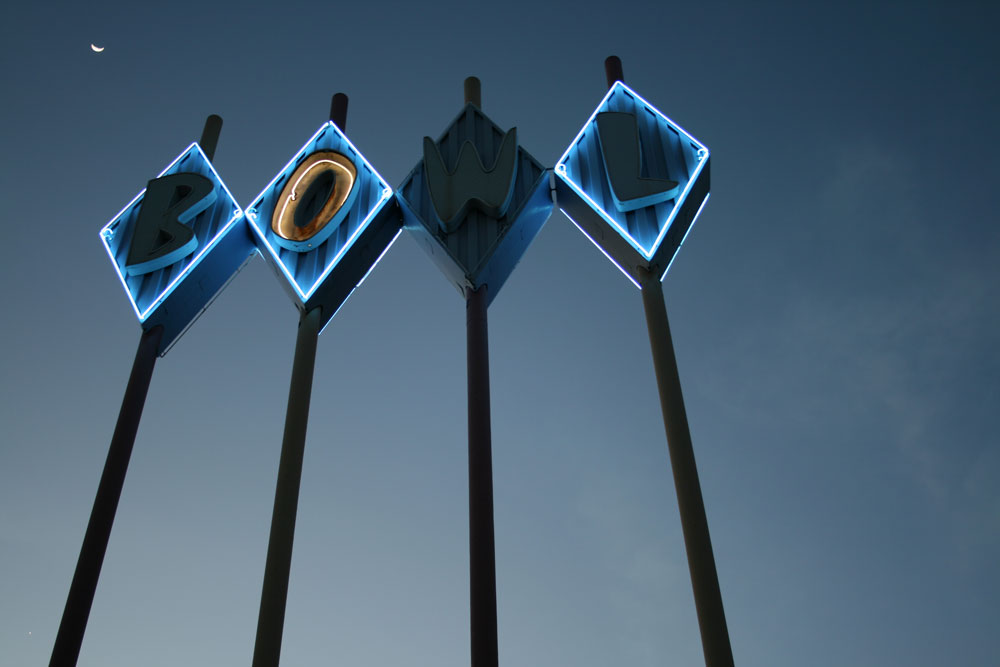
to Rev. Charles Stanley. Courtesy of the Discordian Archives.

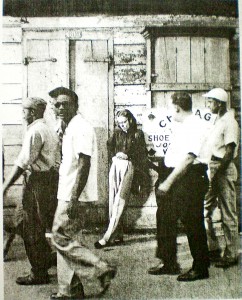
Barbara Reid was not only a voodoo practitioner, beret wearing bohemian, Early Discordian Society member and traditional jazz buff, but she was also a key witness in Jim Garrison’s investigation.
As Discordian history instructs, Reid claimed that she saw Kerry Thornley and Lee Harvey Oswald together in New Orleans in September 1963, although Thornley denied this accusation, insisting that the last time he’d been in contact with Oswald was at El Toro Marine Base in 1959.
According to Jim Garrison in On The Trail of the Assassins (Amazon):
“From his own admission, as well as from the statements of Barbara Reid and a number of others, we learned that Thornley had been in New Orleans in 1963, finally leaving the city only a few days after Kennedy’s murder. Reid, a long-time French Quarter resident who had known both Thornley and Oswald, described seeing them together on several occasions. One of them was in early September 1963 at the Bourbon House, a combination bar and restaurant in the French Quarter. Thornley, who usually wore his hair extremely long, had just returned from a trip out of town. This time he was wearing his hair unusually short and closely cropped, as Oswald invariably did. Reid recalled having said to them, “Who are you guys supposed to be? The Gold Dust Twins?
“We were eager to talk to Kerry Thornley, but he was not an easy man to locate. It took us a lot of legwork and more than a year to do it. We had investigators going to every place in the French Quarter until we learned what had been his main hangout—Ryder’s Coffee House. Except for occasional visits to the Bourbon House on Royal and Bourbon Streets, Thornley seldom went anywhere else.” 00001
Inside the span of two mere paragraphs, Garrison was able to stuff a staggering amount of misinformation. His claim that Barbara Reid knew Oswald has no factual basis, as Reid’s only encounter with Oswald (or someone she thought was Oswald) occurred during her supposed sighting of Oswald and Thornley at the Bourbon House in September 1963.
How Garrison came up with the notion that Reid actually knew Oswald is another head-scratcher. Reid never claimed that she knew Oswald. In her 1968 affidavit, Reid recalled “associating a sense of familiarity with this individual who had received some publicity as a Communist because of his earlier activity of distributing Fair Play for Cuba leaflets in front of the International Trade Mart in New Orleans.”
Garrison further states that Reid saw Thornley and Oswald together on several occasions. However, Reid never said anything of the sort. The only time Reid claimed she saw Thornley and Oswald together (according to her affidavit) was at the Bourbon House.
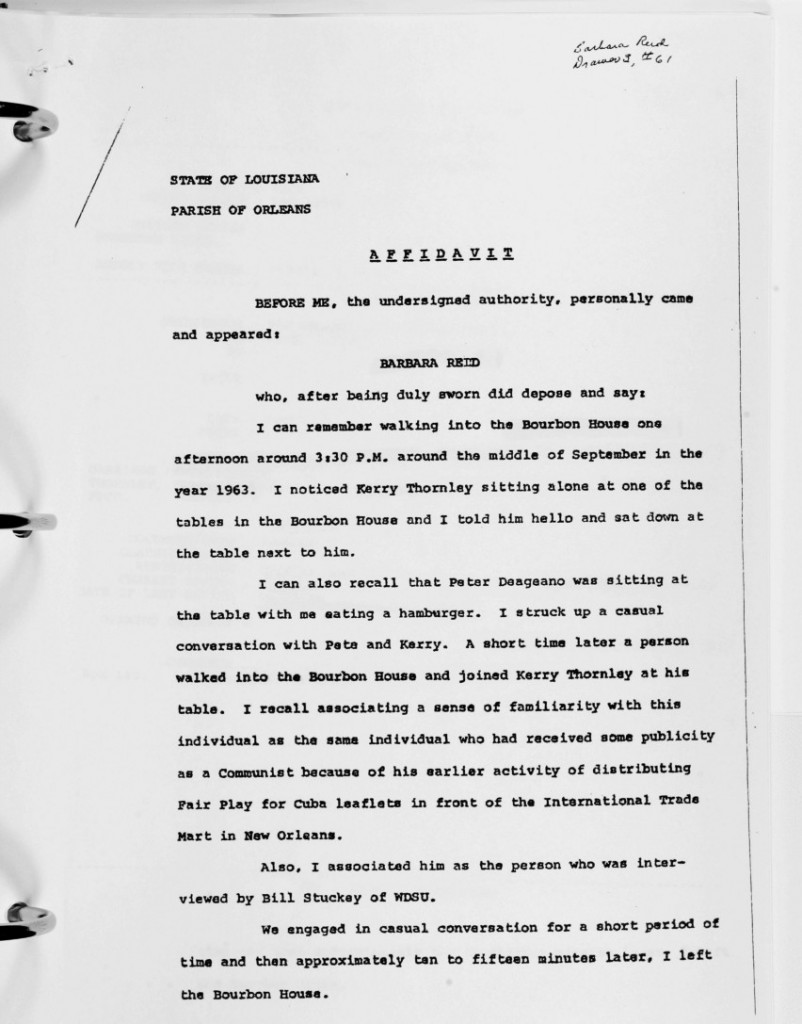
Reid’s claim that she told Oswald and Thornley they looked like “the Gold Dust Twins” is another little nugget that didn’t appear in her 1968 affidavit, suggesting that Reid later spiced up her story (during her 1978 interview with the House Select Committee on Assassinations) to fit with Garrison’s theory that Thornley was one of the notorious Oswald doubles.
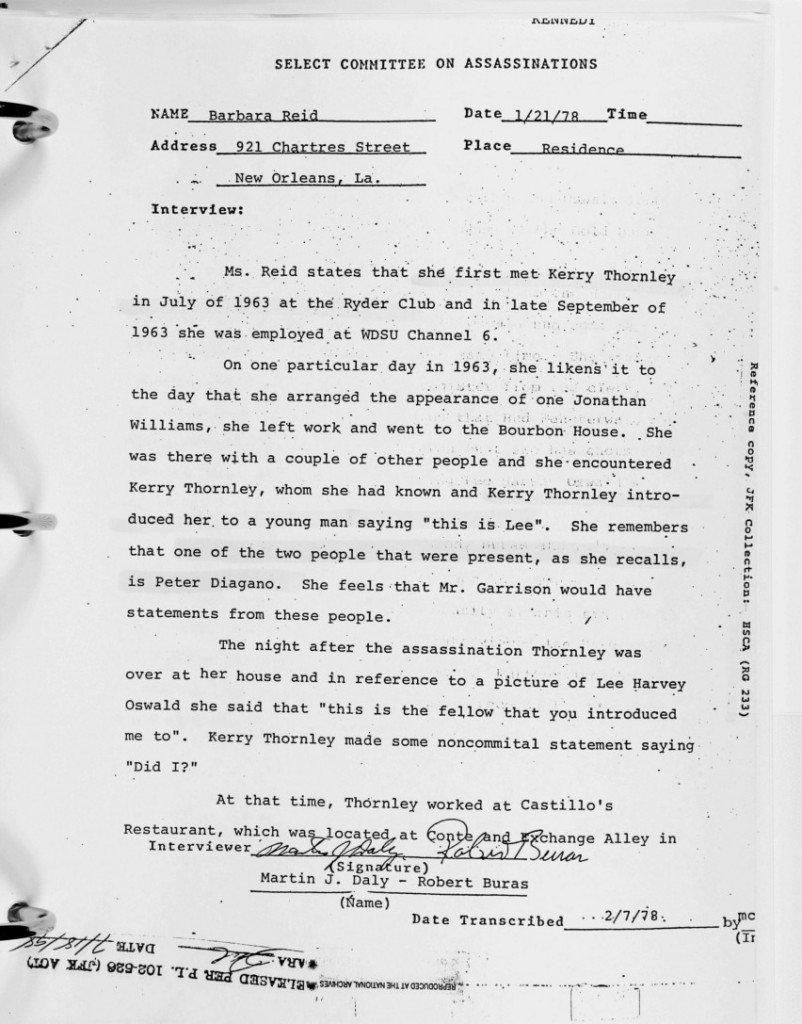
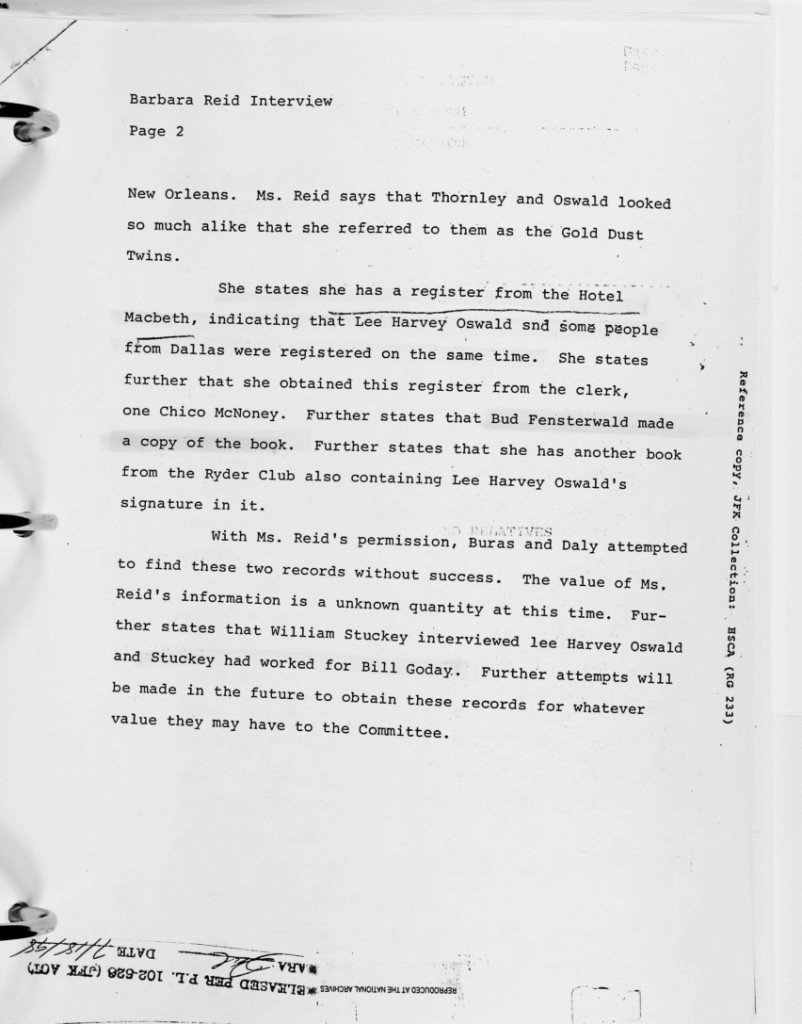
Garrison’s claim that Thornley “wore his hair extremely long” has no substance. Thornley—as was the style of the day—let his hair grow long in the late 1960s, but the claim that he sported a new haircut to more resemble Oswald in 1963 is just another among Reid and Garrison’s impossible-to-prove-allegations.
I suspect the reason Garrison glommed on to the notion that Thornley sported long hair may have been on account of a July 1967 memo (posted below) from Assistant District Attorney Jim Alcock documenting his interview with Clifford Wormser, owner of Cliff’s Junkyard in New Orleans.
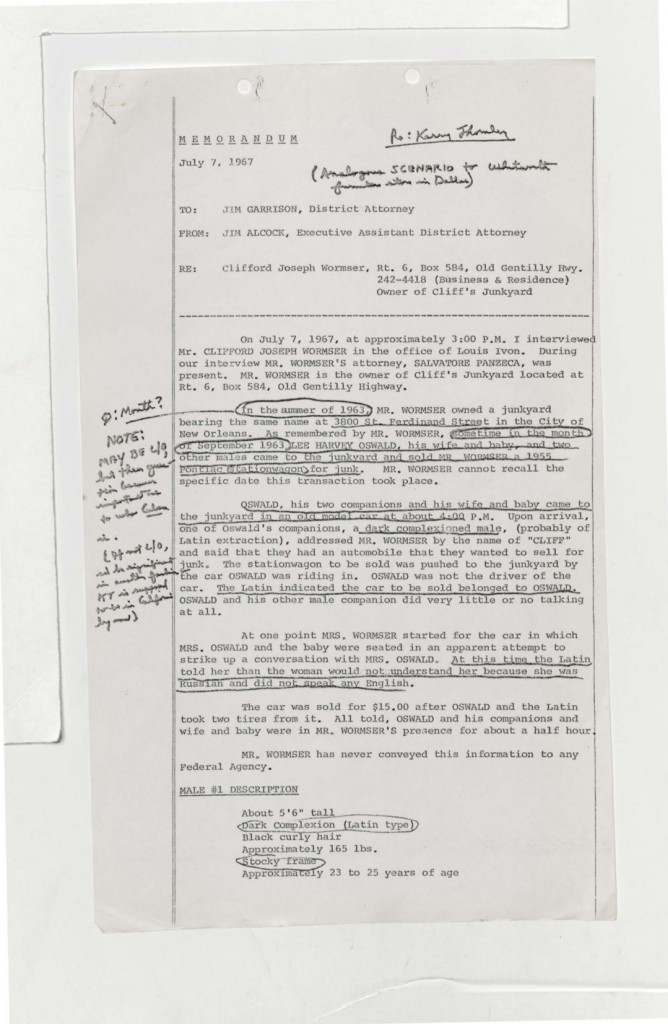
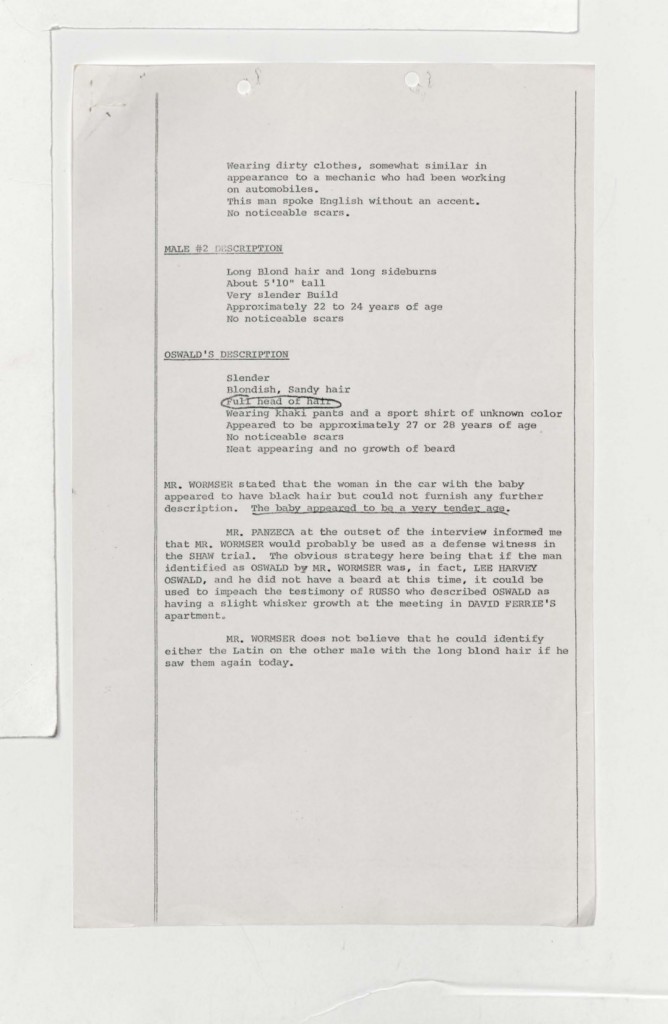
According to Wormser, he was visited in September 1963 by Lee Oswald, his wife and baby, along with two other men, one a Latin looking fellow and the other a Caucasian with long blond hair. At the top of the memo, Garrison scribbled ‘Kerry Thornley’ indicating his suspicion that Thornley was one of the individuals accompanying Oswald during this junkyard visit.
Late September 1963 was the time-frame when Lee Oswald and Kerry Thornley were both in New Orleans during a 2 to 3 week period, which evidently led Garrison to theorize that the long blond haired fellow identified by Cliff Wormser was actually Thornley, and that Kerry cut his hair shortly afterwards. One of the problems with this scenario was that Thornley had brown hair, not blond.
Whatever the case, the apparent intent of Thornley cleaning up his act with this fresh new haircut (once again according to Garrison’s convoluted theory) was due to his recurring role as an Oswald double, which begs the question: If Thornley was masquerading as an Oswald double why would he have allowed himself to be seen in the company of Oswald? Wouldn’t that have potentially compromised the whole Oswald double caper?
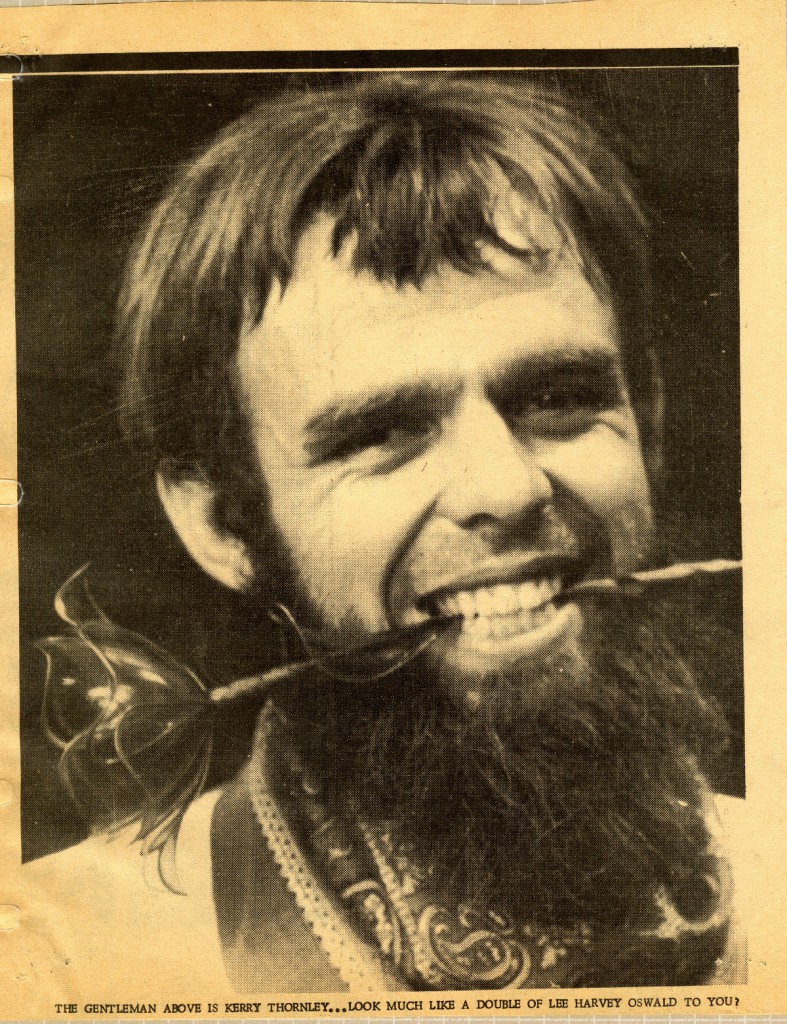
Garrison’s assertion in On The Trail of the Assassins that Thornley left New Orleans a few days following the assassination was also inaccurate, as it was actually three weeks after the assassination that Thornley moved to Arlington, Virginia on December 13th, 1963. This might seem like splitting hairs to some, but it only goes to illustrate how—when it came to Thornley—Garrison never got anything exactly right, and more often got it totally wrong.
To suggest that Thornley was difficult to locate was another fallacy perpetrated by Garrison to create the aura around Kerry as someone always in hiding or on the lam. At the time, Thornley was married with an infant child and held down dozens of menial jobs, while living at a few locations, in California and later Florida. He was also doing a lot of writing during this period, and his articles appeared in numerous publications. That Garrison encountered such difficulty tracking down Thornley says more about Big Jim’s dubious investigative skills than it does Thornley’s supposed elusiveness.
Garrison’s claim that the Ryder Coffee House had been Thornley’s main French Quarter hangout is also inaccurate. Kerry noted in his writings over the years that the Bourbon House—not the Ryder Coffee House—had been his main base of operations where he spent his idle hours writing or shooting the bull with other patrons. In recent correspondence with your humble author, Thornley’s French Quarter friend, Grace Zabriskie (formerly Grace Caplinger), confirmed that the Bourbon House was indeed Kerry’s main French Quarter hangout, and to a lesser degree, Carlos Castillo’s Mexican Restaurant.
In regards to the Ryder Coffee House, Barbara Reid claimed she had evidence of Oswald and Thornley both signing the guestbook belonging to Jack Frazier, the manager of Ryder’s. In a memo from Harold Weisberg to Garrison, Weisberg noted that “several names may be disguised in this book, for example, Thornley’s in the ‘Discordian’ language on the ninth page. You have the Discordian files that I obtained on a previous trip. These will reflect which Omar Khyam is who….” 00002
Make of this what you will, but apparently Weisberg thought he was hot on the trail of a diabolical Discordian conspiracy and provided Garrison with copies of Frazier’s guestbook as evidence of this perceived diabolism. A review of the guestbook reveals that Thornley did indeed sign it using his Discordian moniker of Omar Khayyam Ravenhurst, which indicates that Thornley visited Ryder Coffee House on at least one occasion. However, there’s no evidence that Oswald—using his real name or an alias—ever signed the guestbook.
Robert Karno—who in the absence of Jack Frazier managed Ryder Coffee House during the relevant timeframe—stated in an interview with Asst. D.A. Jim Alcock that he thought he met Oswald at Ryder’s on one occasion, although he didn’t sound completely positive: “Well, I—I believe I did. I’m almost sure I did…” As for Thornley, Karno remembered meeting him there only once, as well, and said nothing about having seen Thornley and Oswald together. 00003

Omar Khayyam Ravenhurst aka Kerry Thornley.
A second supposed witness to the Oswald/Thornley Bourbon House meeting was a French Quarter bookie named Peter Deageano. According to Deageano’s affidavit:
“It was between 2:00 and 4:00 o’clock in the afternoon either in August or September of 1963. I was sitting at a table in the Bourbon House eating a hamburger. There weren’t too many people in the Bourbon House and as I looked around I noticed Kerry Thornley, Jeanne Hack, and (Oswald) sitting at a table close to me, I looked at them and said hello and either Kerry Thornley or Jeanne Hack introduced him to me. I cannot remember how he was introduced or any of the conversation that we may have had as it was a very casual meeting. However, I remember thinking to myself that he might be related to Kerry Thornley as he resembled him quite a bit.
“After the assassination of President Kennedy a picture of Lee Harvey Oswald appeared on television and I immediately recognized him as being identical to the person that I saw sitting in the Bourbon House with Kerry Thornley…”
Although it’s not indicated in Deageano’s affidavit—which happened to be unsigned—he was in Barbara Reid’s company during this alleged Oswald/Thornley sighting. That Deageano’s affidavit remained unsigned speaks volumes (perhaps) to the methods of Garrison and his staff. Nowhere else in Garrison’s files does an actual interview with Deagano appear, and it’s my suspicion that Reid and/or the D.A.’s office drafted the affidavit, but when they presented it to Deagano he refused to sign it, assuming it was ever shown to Deagano at all.
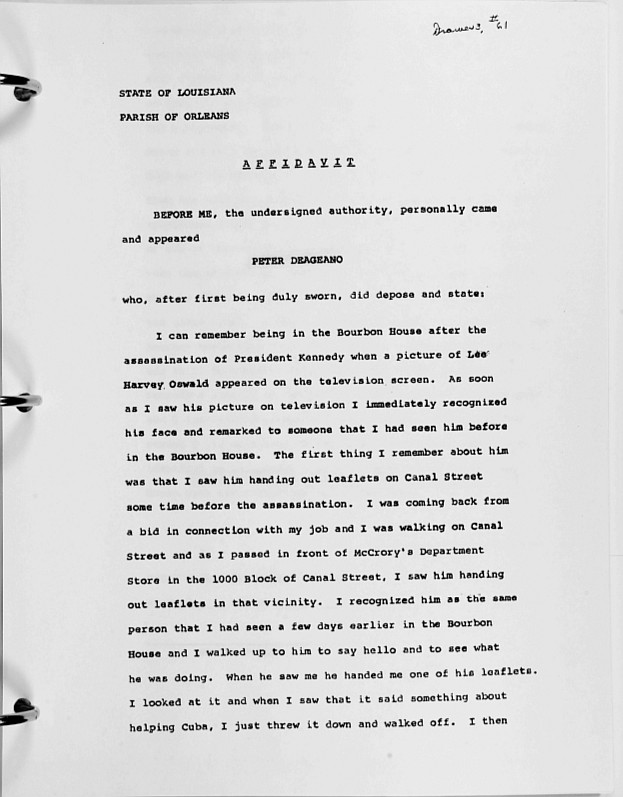
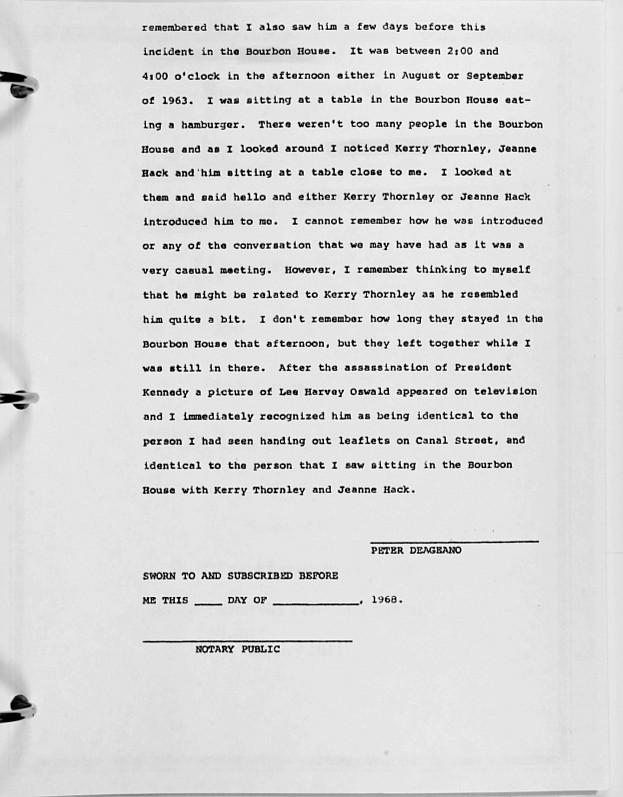

Read Part 1 of this series here.
00001 Jim Garrison, On The Trail of the Assassins, p. 70-72.
00002 3/17/68 memo by Harold Weisberg, http://jfk.hood.edu/.
00003 May 14, 1968 conversation between James L. Alcock and Robert Karno. Jim Garrison Papers, National Archives, John F. Kennedy Assassination Records Collection.

The Truth Shall Set You Confused… in 2,500 words or less!
2015 (or 3181 on the Discordian calendar) marks the 50th anniversary (maybe!) of the first edition of Principia Discordia, or How the West was Lost, published in New Orleans, Louisiana in 1965, consisting of a mere five copies that—according to Discordian co-founder Greg Hill—“were mostly lost.”
The details surrounding this rare 1st edition are enshrouded in as much myth and mystery as the JFK assassination itself, which—it so happens—will be forever linked to Discordianism due to its association with Discordian Society co-founder Kerry Thornley who served with Lee Harvey Oswald in the Marines.
Curiously enough, Thornley was writing a book based on Oswald three years before the Kennedy assassination and afterwards testified before the Warren Commission and was later accused (ridiculously so) by New Orleans District Attorney Jim Garrison as being part of a JFK assassination conspiracy.
The Discordian Society included in its ranks such illuminated seers as Robert Anton Wilson (RAW) who noted in Cosmic Trigger: The Final Secret of the Illuminati: Volume 1:
“A search through the Discordian Archives revealed that the earliest of the Discordian holy books—How the West Was Lost, by Malaclypse the Younger (Greg Hill) — was originally printed on the Xerox machine of D.A. Jim Garrison, in summer 1963. (Greg’s girlfriend was Garrison’s secretary.)”
Thus was birthed the legend of how this mostly missing 1st edition was copied on a Xerox machine belonging to the very same man, Jim Garrison, who would later link Kerry Thornley to a shadowy cabal that allegedly orchestrated Kennedy’s awful offing.
Although RAW was partly correct regarding Jim Garrison’s association with the 1st edition Principia Discordia (PD), it appears that he might not have had his facts quite right. In the Loompanics edition of PD, Greg Hill added an afterword in which he corrected RAW’s claim about the Garrison copying machine caper:
“…Bob [RAW] says that when Oswald was buying the assassination rifle, my girlfriend was printing the first edition of Principia on Jim Garrison’s Xerox. It wasn’t my girlfriend, it was Kerry’s; it wasn’t the First Ed Principia, it was some earlier Discordian thoughts; it wasn’t Garrison’s Xerox, it was his mimeograph; and it wasn’t just before Kennedy was shot but a couple of years before that… The First Ed Principia, by the way, was reproduced at Xerox Corp when xerography was a new technology. Which was my second New Orleans trip in 1965. I worked for a guy on Bourbon Street who was a Xerox salesman by day.”
Afterwards, Hill received further clarification from Kerry Thornley, which he added as a footnote to his Loompanics afterword:
“I checked this further with Mr. Thornley. He says that the woman in question was not his girlfriend, she was just a friend, and it wasn’t a couple of years before Kennedy was shot but had to be a couple of years after (but before Garrison investigated Thornley).”
To confuse matters more (Hail Eris!), Thornley’s introduction to the IllumiNet Press edition of PD states:
“…the First Edition of Principia rolled off District Attorney Jim Garrison’s mimeograph machine (without his knowledge) in New Orleans in 1964. That was the work of Gregory Hill and of Lane Caplinger, a Discordian typist in the DA’s office.”
During the course of researching The Prankster and the Conspiracy: The Story of Kerry Thornley and How He Met Oswald and Inspired the Counterculture (2003 Amazon), I exchanged email correspondence with Lane Caplinger’s sister, actress Grace Zabriskie. For some reason, it’d never dawned on me to ask Grace about the legend of the 1st edition—probably because Grace, by her own choosing, was never really part of the Discordian scene.
In December 2012, I contacted Grace via email with some follow-up questions for my then book in the works Caught in the Crossfire: Kerry Thornley, Lee Oswald and the Garrison Investigation (Amazon) and at that time asked: Was the Garrison copying machine caper “truth, legend, or a combination of both?” Grace passed on my query to her sister Lane who replied, quite simply: “Legend. I recall occasional Discordianism reading and giggling only.”
Lane’s response now leaves us in a quandary and seems to put the kibosh on this whole wonderful mythos that the PD was created right under Jim Garrison’s nose by a diabolical Discordian conspiracy.
But wait, let’s not be in a hurry to dismiss the Garrison mimeograph legend. If we examine each of the seemingly conflicting stories regarding the origins of the 1st edition PD, I think in the final analysis there’s some measure of truth to each story, or as the old Discordian saying goes:
All statements are true in some sense, false in some sense, meaningless in some sense, true and false in some sense, true and meaningless in some sense, false and meaningless in some sense, and true and false and meaningless in some sense.
In the IllumiNet Press introduction to PD, Kerry Thornley identifies 1964 as the year of the publication of the 1st edition and that Greg Hill and Lane Caplinger were the culprits.
Thornley moved to Arlington, Virginia in late 1963 through 1964. Meanwhile, Greg Hill returned to New Orleans in 1964 and was there until mid-1965, which was the relevant period when the 1st edition was published.
My working theory is that Lane Caplinger did indeed run off some mimeograph copies of letters and writings by Hill and Thornley that later found their way into the first edition PD. However, it’s my impression that Lane had but a vague idea at best of what she was involved with—other than just copying some material for a couple of friends who were tinkering around with a joke religion called Discordianism.
As Greg Hill noted, only five copies of the 1st edition Principia Discordia were produced, most of which were lost. Later iterations of PD departed greatly from that long ago 1st edition, evolving into a collaborative art project that included the involvement of such notables as Robert Anton Wilson (Mordecai the Foul), Robert Shea (Josh the Dill), Camden Benares (The Count of Fives), Robert Newport (Rev. Hypocrates Magoun), Bob McElroy (Dr. Mungojerry Grindlebone)—and, of course, Thornley and Hill.
I first became involved in researching this craziness in the late-90s when I was overtaken with an obsession of writing a biography of Kerry Thornley, who had captured my imagination not so much due to my interest in Discordianism (that would come later) but because of all the other high weirdness surrounding his life.
In 2001, I initiated a Freedom of Information Act request for any Kerry Thornley related documents in the CIA and FBI files. Shortly after I was informed by the Feds that these Thornley FOIA materials had been previously released and were available through the National Archives. In short order, I obtained the materials, most of which had been assembled during the House Select Committee on Assassinations (HSCA) in 1977 and released to the public in 1992 through the Assassination Archives Research Center (AARC.)
In this Kerry Thornley-National Archives package were documents related to Jim Garrison’s investigation, including 36 Discordian related pages which didn’t mean a whole lot to me at the time as I was more interested in getting to the bottom of Thornley’s alleged Kennedy assassination associations than I was all of this Discordian doo-dah. If I’d been paying closer attention, I would have noticed that these Discordian related materials appeared to be the first edition of Principia Discordia, Or How the West Was Lost—or at least a collection of writings from the early days of The Discordian Society. These same materials were later identified in 2006 as the 1st edition PD by a fellow named Karl Musser, who came across the material during a visit to the National Archives.
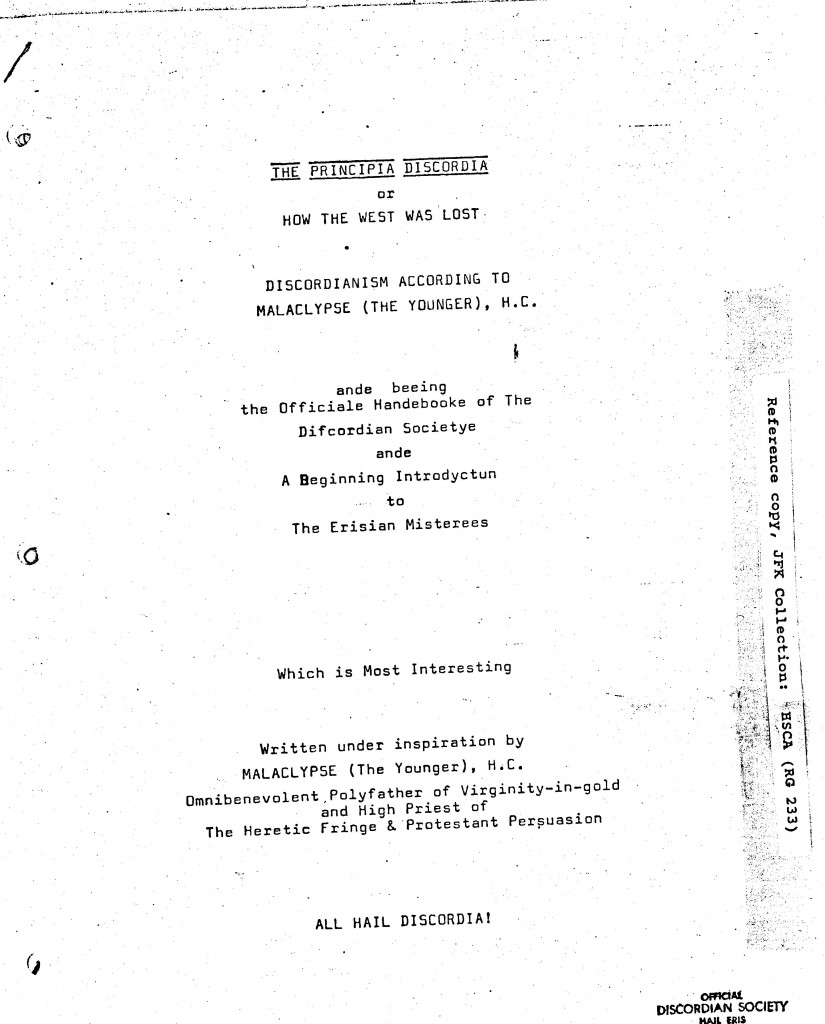
At the time, Musser shared these documents with Discordian historian Dr. Jon Swabey who afterwards transcribed this apparent 1st ed. PD and posted it on the Internet via Creative Commons.
At the time, I was unaware that the Musser/Swabey tag team had brought to the Discordian world this apparent 1st edition PD. A couple years later, Dr. Robert Newport passed on to me Greg Hill’s Discordian Archives, consisting of all 5 editions of PD. However, the discovery of these different PD editions wasn’t immediately apparent and it took me some time to sift through the Discordian Archives and identity exactly what was what. The most amazing discovery of all was an actual honest-to-Goddess copy of the first edition of Principia Discordia, Or How The West Was Lost, numbered one of five, written in Greg Hill’s own hand.
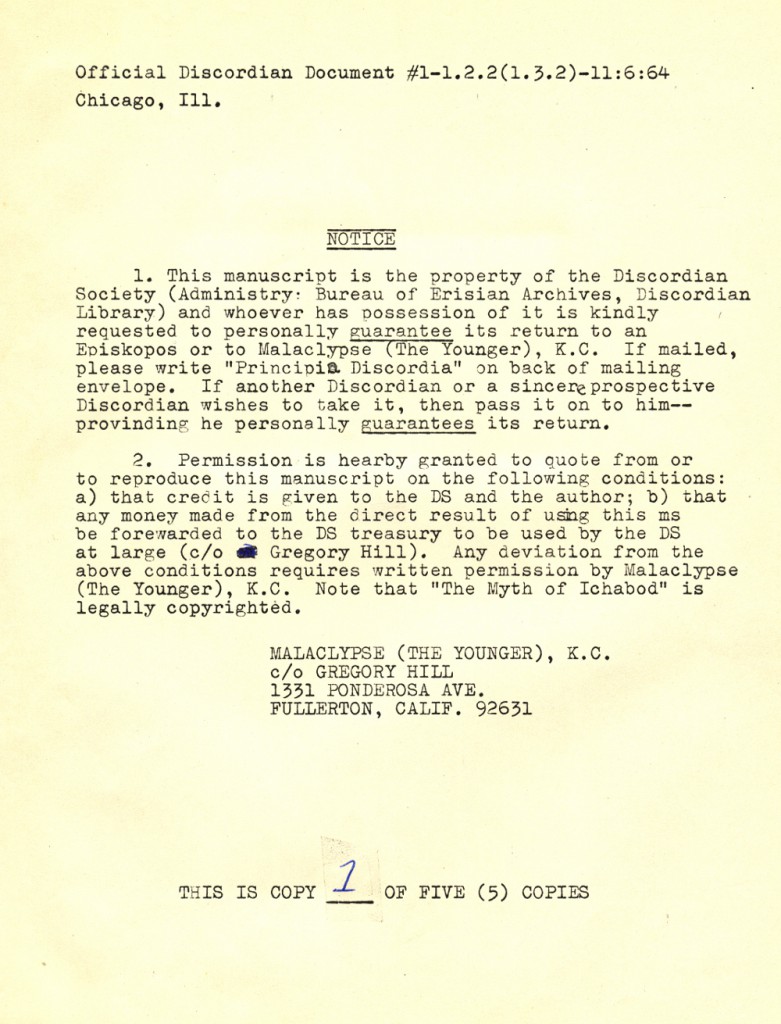
My discovery of the Holy Grail of Discordianism led to a period of intensive research into the history of PD. After a review of the Musser/Swabey/National Archives version of PD, I initially arrived at the conclusion (which I now consider erroneous!) that the National Archives version was a later and incomplete reproduction of the 1st edition PD. However, more recently I’ve come to suspect that the National Archives version is actually an early draft of PD.
For sake of clarity, I’ll henceforth refer to these two different versions of Principia Discordia, Or How The West Was Lost as: 1) the National Archives (NA) version, and, 2) the Discordian Archives (DA) version.
Although there are similarities between these two versions—the NA and DA—there are also a number of differences, one of which is the type font. Secondly, the NA version numbers only 36 pages while the DA version comes in at a whopping 60 pages including a number of illustrations that do not appear in the NA version.
My reasoning behind this theory—that the NA version is an early draft of PD—is based, in part, on the handwritten address on the front cover:
Kerry Thornley
5326 85th Street
Apartment T-3
Lanham, Maryland
At first glance, I was a bit befuddled by this address because Thornley’s Warren Commission testimony stated that he’d moved to Arlington, VA in late 1963 and lived there until late 1964. But after giving it some thought, I remembered correspondence in the Archives where Thornley noted that he’d stayed for a period of time—in late-1963/early–1964—with his friend Robert McDonald in Maryland before his Arlington move. This provides further evidence that the NA version actually predated the DA version, and that some of the content in the NA version (as my theory goes) were pages Lane Caplinger ran off on Jim Garrison’s mimeograph machine.


Additionally, my colleague Grouchogandhi pointed out that on the title page of the NA version the author is listed as “Malaclypse the Younger, H.C.” The curiosity, in this instance, is the title of “H.C.” In subsequent editions of the PD—including the 1st edition in the Discordian Archives (DA)—Malaclypse is referred to as “K.C.” (Keeper of the Chao) and in later editions as “K.S.C.” (Keeper of the Sacred Chao).
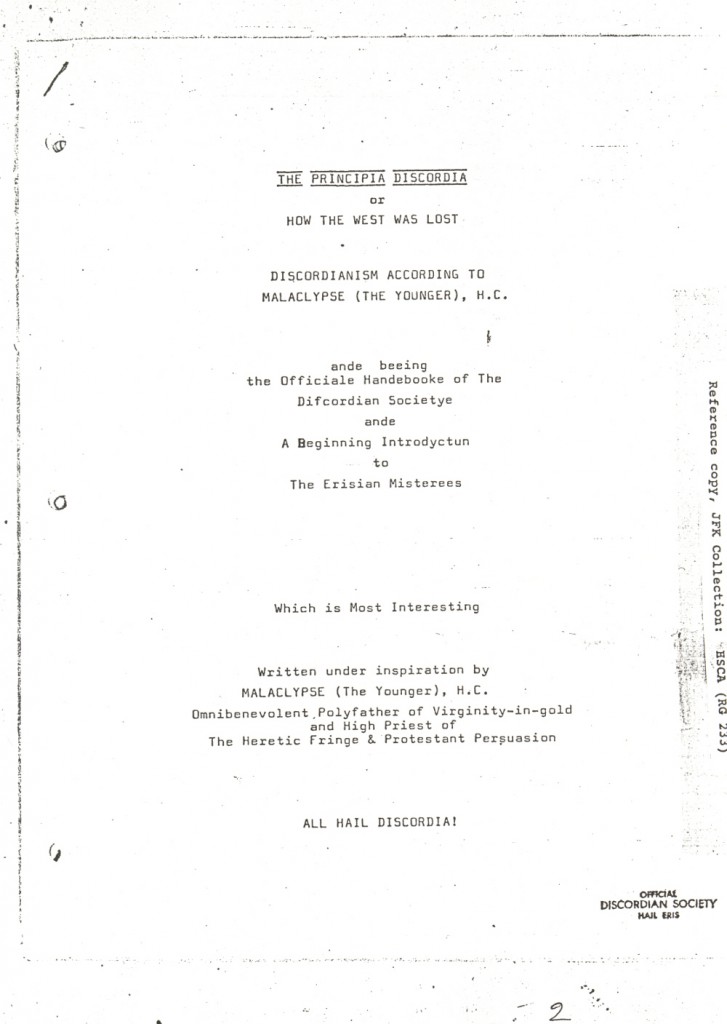
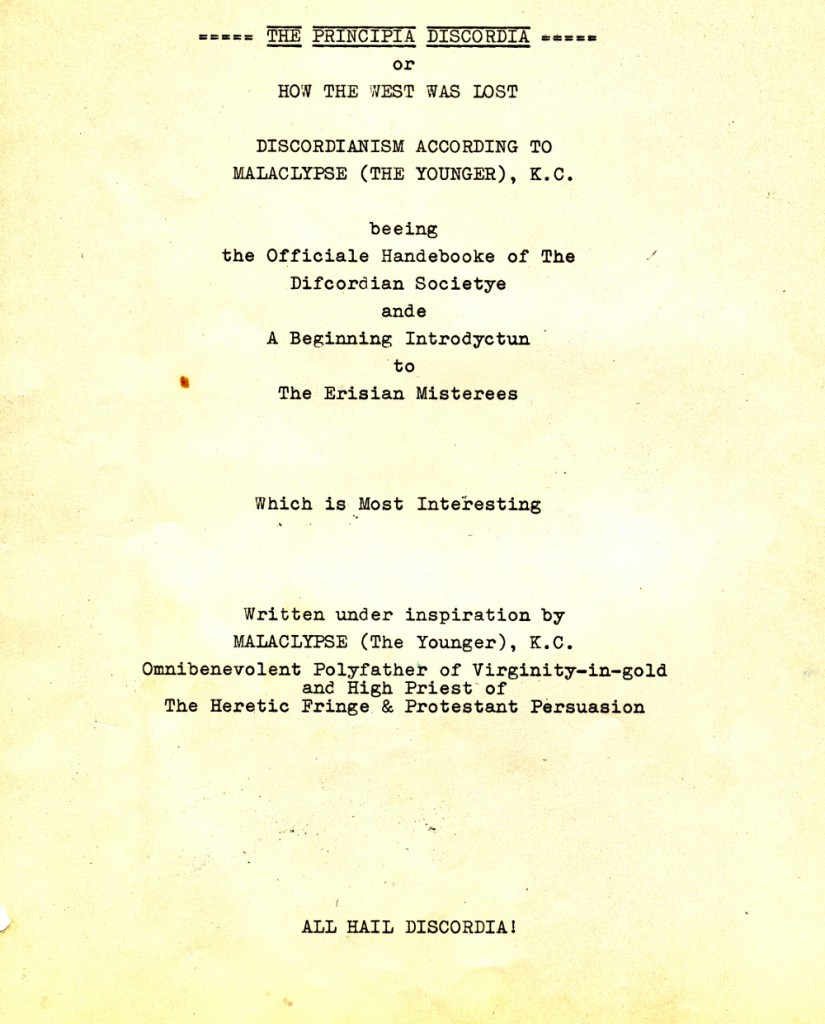
The third page of the NA version consists of a Legion of Dynamic Discord (LDD) certificate awarded to early Discordian Barbara Reid. Conversely, this certificate does not appear on the third page of the DA version. However, there is a blank LDD certificate on page 55 of the DA version, which suggests that the NA version was sent from Kerry Thornley (aka the Bull Goose of Limbo) to Barbara Reid in 1964 and included a signed LDD certificate as confirmation of Reid’s ordination into the Discordian Society.
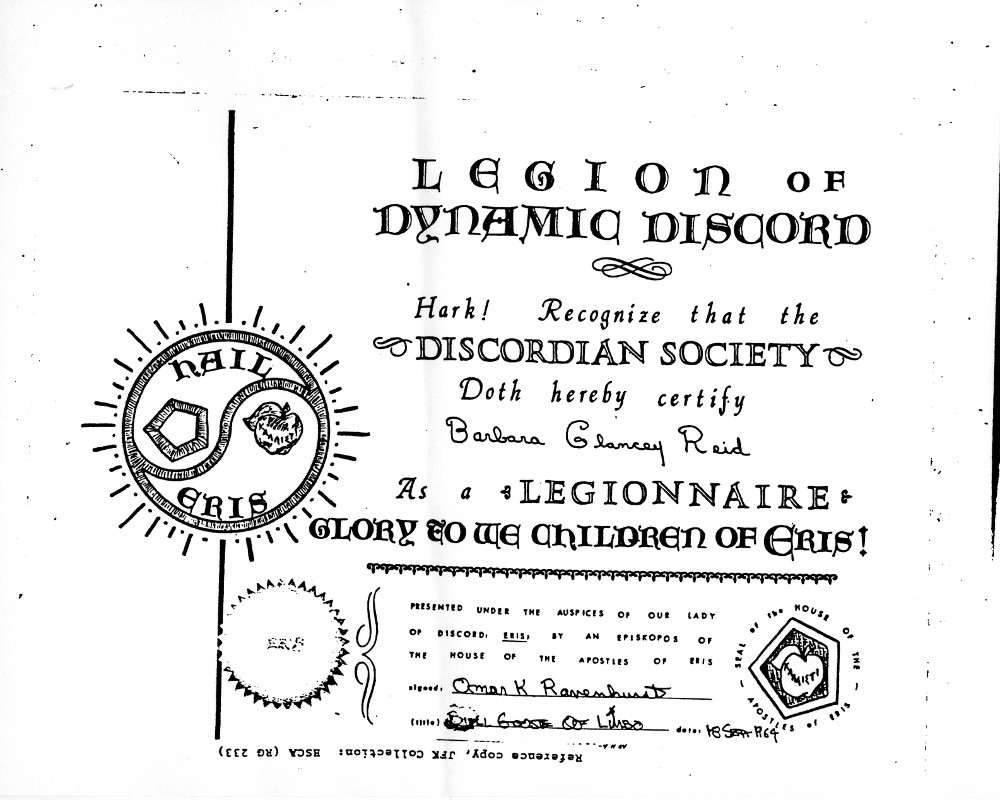

So how, pray tell, did this early Principia Discordia draft wind up in the House Select Committee on Assassinations (HCSA) files? My guess is that Barbara Reid provided the document to the HSCA in the late-70s when she testified before the committee regarding her claims that she saw Kerry Thornley in the company of Lee Oswald in New Orleans in September of 1963. However, another person who might have submitted this document to the HSCA was assassination researcher Harold Weisberg, who worked closely with Barbara Reid during the Garrison Investigation period and entertained the notion, at one time or another, that the Discordian Society was some type of CIA front organization involved in the Kennedy Assassination dance party.
Hail Eris, indeed!
Adam Gorightly presents a brief introduction to the 1st edition of the Principia Discordia, courtesy of Brenton Clutterbuck of Chasing Eris.
Adam Gorightly presents the 1st through 5th editions of the Principia Discordia.
Gorightly interviewed by Jim Harold on Discordianism, Kerry Thornley, 23, The Church of the SubGenius, Robert Anton Wilson, and more!
http://jimharold.com
http://jimharold.net
Video by Floyd Anderson located here on The YouTube.
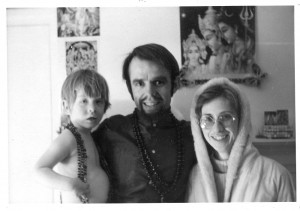
The Watts house became a blend of memorabilia and psychedelia. Antique window glass was decorated with pieces of translucent contact paper, to give it the effect of stained glass, as multicolored sunlight streamed through the strips of dangling paper. An ornately carved wooden mantle clock had the word “NOW” written on a round placard which covered its face. An old-time radio stood in the corner of the dining room, but now instead of playing Amos ‘n Andy and Fibber McGee and Molly, the big old box was tuned into Peter Bergman’s Radio Free Oz, booming music by Ravi Shanker, Simon and Garfunkel, and The Beatles.
With plenty of room for guests to roam around, the Watts house became a psychedelic social club. One frequent visitor was Bud Simco who recalled:
“Kerry was charismatic and had the ability to attract diverse personalities, people who would normally not be associated with each other, except by the force of Kerry’s personality. For example, there were so-called hippie types tripping under the dining room table, holding burning candles in their hands, while right-wing types were holding forth in the kitchen. One such character I recall had never been to Watts before, and showed up wearing a bullet proof vest and armed with a .45. He seemed reasonable enough, in conversation, but he was taking no chances (having never been around hippies before). There were people from all walks of life… including a pilot for the Flying Tiger Airlines, a student from MIT, some swingers, a fashion model, some writers, some SDS student types, and various and sundry others whom I did not know. One of my guests at one particular gathering was a former motorcycle gang member who lost his foot in a motorcycle accident, and his beautiful American Indian wife, who was at the time a co-worker of mine. He had never seen such an assorted group of people in his life, for example, but with his tambourine, magic mushrooms and a Donovan LP loudly playing, asserted his presence along with all the diverse others in one righteous happening. The thing is, everyone was tolerant of the other, regardless of individual inclinations and/or politics. At such an event, many people would never even interact with other groups, in other rooms, although many did. That was the one universal factor re: being present at one of Kerry’s gatherings, either at his home in Watts, or perhaps at one of the original ‘Be-Ins’ at Griffith Park.”
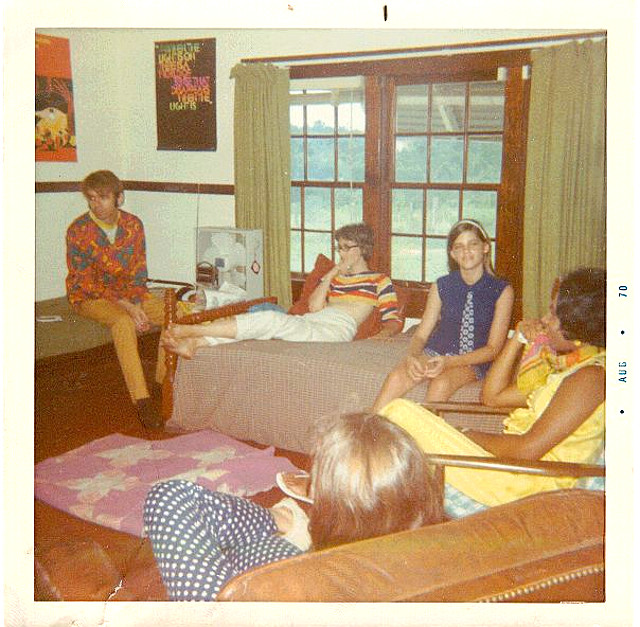
At the Griffith Park Be-In, Kerry Thornley cut a singular swath, equipped with a sign bearing a perfectly surreal statement that seemed to say one thing while also saying something else entirely, just the sort of irreverent psychedelic koan that Kerry became famous for throughout his life. His sign read:
Fellow Discordian Louise Lacey also attended the Griffith Park Be-In. She recalled:
“The weather was perfect. We were all stoned. A single engine plane came and circled, and I thought it was the media, keeping track of us, but then a man all in white dropped down with a parachute and the crowd roared with approval. Later I learned that an old friend of mine from Marin County was the pilot. He got that plane out fast, because it was illegal to parachute within the city limits.
“The Be-In was fascinating because I had never seen such a large collection of freaks. I couldn’t keep from grinning. I was particularly interested because some hard-assed sociologist had said that when you were on LSD you were extremely susceptible to being led. I was watching for people being led.
“I saw a group of people organized into a crack-the-whip game. Twenty or twenty-five people formed and a man with a megaphone was giving them instructions. (Definitely planned.) ‘Move up the hill, move down. Hang on tight. Join with more people.’ I couldn’t tell if anyone was listening or just all having fun. The people at the end of the line were moving so fast they kept being thrown off, tumbling down the hill in the grass, laughing hysterically. Then some of the crack-the-whip people let go of the hands of the people around them and drifted off. The megaphone man yelled more loudly. ‘Hang on, don’t let go.’ More people drifted away. He was screaming now. The group all dropped hands and disappeared in the crowds and the megaphone man was screaming at the top of his amplified voice, ‘Come back! We are playing a game here!’ But the people were gone. I didn’t worry any more about what that sociologist had said.
“Many groups of people were gathered as families of friends. It was the first time I had seen this form of organization. So there were tents, and lean to’s and lots of signs pounded into the dirt, describing one thing or another to identify who the friends were. (This is where Kerry’s sign fit in.) As I didn’t live in LA, I didn’t recognize anyone other than Kerry’s friends, who didn’t stay around his sign, but it didn’t matter. I ‘knew’ the strangers as friends, and we laughed and hugged and shared doobies, and listened to music and I moved on. Nobody got hurt, everyone had a good time (except, I imagine, the man with the megaphone). As the day progressed, I gravitated back to Kerry’s sign and others did, too, and we shared what we have experienced, eventually gathered our stuff and drove home to Kerry’s. A most successful day.”

In March 1967, the Los Angeles Free Press ran an article about how you could get high from smoking banana skins, including instructions on how to prepare the stuff. Kerry decided to give this new craze a go, and in the company of co-conspirator Louise Lacey visited the local Safeway supermarket, as the two of them cleaned out the produce section of their banana supply, then brought home the banana bounty, removed the fruit and baked the inner portions of the skins on cookie sheets just as the Los Angeles Free Press article had instructed.
While this cosmic concoction was cooking, Kerry and Louise went around the Watts neighborhood, ringing door bells and offering skinned bananas to any interested parties. As Louise recalled: “This was a mostly black neighborhood, who knew Kerry, at least by sight, but still they weren’t interested. He explained that it was an experiment, and that no one had messed with the bananas (which were getting brown), but they thanked him and shut the door, again and again, so we gave up.”
Kerry’s friend Becky Glaser remembered walking into Kerry’s house and discovering that every container conceivable was filled with peeled bananas. Becky said she will always remember the wild look in Kerry’s eyes, when she walked in and asked him:
“And what the hell are we gonna do with all these fucking bananas?!”
“Well, I’m urging you all to eat them.”
“And what’s gonna happen if we eat them?”
“I’ll get rid of them!”
“Yeah, but what are you going do with the peels?”
“Aha! That’s the important part!”
As Kerry’s brother, Dick Thornley, remembered: “Kerry enthusiastically invited me over for some Mellow Yellow that night. The invitation came after they had baked it. I recall the stuff was essentially powdered charcoal by the time it came out of the oven. It was nearly impossible to light, let alone smoke.”
The Mellow Yellow craze is now considered an urban legend that was promoted by the Los Angeles Free Press article and Donovan’s groovy tune of the same name. According to the liner notes of Donovan’s Greatest Hits, the rumor you could get high from banana peels was started by Country Joe McDonald of Country Joe and the Fish.
Whatever the origin of the Mellow Yellow mythos, Louise Lacey remembers that inhaling the banana skins was anything but mellow. As for copping a buzz, the only one who got off on the stuff was Kerry, who after toking down on a Mellow Yellow reefer, proclaimed, “I’m high!” Leave it to Kerry to be the only person in the history of the Mellow Yellow craze to actually get off on the stuff. Of course, this wasn’t out of the ordinary, because—as Becky Glaser recalled—“Kerry got high off of everything.”
Hear the Mellow Yellow story from an interview I conducted with Louise Lacey in 2007. Play below or download the MP3 here.
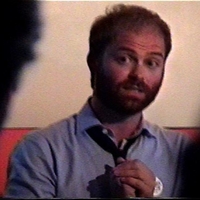
One of Discordianism’s two founders, Kerry Thornley, famously declared that if ‘religion is the opium of the masses, [then] Discordianism is the marijuana of the lunatic fringe,’ and this is made nowhere more clear than in its material culture over the last fifty-six years.2 The majority of Discordianism’s material culture has been comprised of self-published work in the form of religious certificates, ‘zines’, APAs (amateur press associations), live audio recordings of Robert Anton Wilson lectures, and, with the advent of the internet, BBSes (Bulletin Board System), PFDs, and blogs.3 The paper ephemera of Discordianism’s material history has not been catalogued by libraries, nor preserved by universities, but commonly remains in the possession of its initial recipients, or forgotten in the boxes that compose private zine archives. Lacking any familiarity with this ‘underground’ material, scholarly analysis of the mass-marketed Discordian texts, and Discordianism in toto, has been altogether superficial.
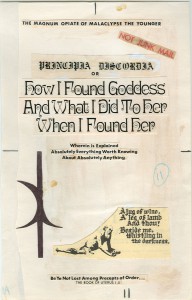
The second issue concerns the lack of scholarly convention concerning which version of the Principia is regarded as authoritative. As a result of the 4th edition Principia’s ‘copyleft,’ or anti-copyright status, there are no less than five different published versions of the 4th/5th edition, in addition to innumerable online versions. While there is not a great deal of difference between versions, scholarly neglect of this point, as well as the lack of convention concerning which version of the 4th/5th edition of the Principia should be treated as authoritative, has instilled an unnecessary amount of irregularity into the study of Discordianism.6
The third issue is partly based on the first, but regards a more general misinterpretation of the meaning of the Principia within the Discordian milieu. Scholars regard the 4th/5th edition of the text as the central Discordian holy work, and it is not hard to understand why; it seems to offer all of the requisite data for a normative appraisal of a religious movement. It contains an origin story for the religion, a list of commandments, a liturgical calendar, a list of saints, and an account of Discordianism’s principle deity, Eris. In sum, the 4th/5th edition of the Principia seems to be a perfect index of everything a ‘real’ religion needs. This, of course, is precisely the problem. Leaving aside the fact that many of the aforementioned ‘religious’ aspects of Discordianism were added in successive editions of the Principia, the primary issue here is that Discordianism is explicitly not based on liturgical observance or orthopraxis, but rather on the utilization of beliefs as heuristic tools. Scholarly preoccupation with the religious minutia contained in the Principia evidences that scholars have missed an essential aspect of the Discordian ludibrium.
Since the various publications of the 4th and 4th/5th editions of the Principia read like conventional holy texts, or at least as a parody of one, scholars have mistakenly taken it as the text that has governed Discordianism since its inception. While some contemporary Discordians may revere it as such, familiarity with previous editions of the text, let alone the history of Discordianism, make it clear that this was not always the case. Discordianism did not reach underground audiences until nearly two decades after it was founded, and even then it was not an edition of the Principia that publicized the religion, but a trilogy of novels. Despite having numerous quotes from the Principia, the fictitious nature of Robert Anton Wilson and Robert Shea’s Illuminatus! trilogy (1975) of novels led many to believe that the Principia did not actually exist á la Lovecraft’s Necronomicon. Needless to say, Discordianism’s underground popularization was not based on teachings outlined in the first, second, third, or fourth editions of the Principia, but Wilson and Shea’s interpretation of them in Illuminatus! The first widely popular edition of the Principia was published nearly five years after Illuminatus! as a result of Loompanics publisher Mike Hoy reading the trilogy, and querying Hill himself as to the existence of such a text.7 The shift to institutionalization in contemporary Discordianism has led to the formalization of Discordian beliefs, and, central to this has been the reframing of the Principia as foundational to the religion. The scholarly preoccupation with the contents of the Principia illustrates the way in which scholars’ research agendas owe more to the contemporary trend towards institutionalization within the religion than rigorous historical research on it.
Read in terms of its evolution and alongside other Discordian material, it is evident that the various editions of the Principia were never merely parodies of sacred texts, nor were they strictly genuine attempts to fashion one. Instead, they were iterations of an idiosyncratic form of genre appropriation based on the conviction that all beliefs are heuristic tools for creating models of reality. Said more precisely, the various editions of the Principia were not just satire, but prime examples of the assiduous playing with religious forms that epitomizes Discordian belief. Essentially, this type of humorous play functions as the liturgical language of Discordianism. Reflecting William Burroughs’s famous adage, ‘nothing is true and everything is permitted,’ Discordianism is a meta-belief system in which abstract concepts like ‘holy scripture’ are utilized as expedient means to destabilize fixed assumptions about reality. Though more salient in later editions, the Principia appropriated the genre of sacred scripture in the same way that Camden Benares’ Discordian treatise, Zen Without Zen Masters (1977), utilizes tropes associated with Zen koan books, and the same is true for the appropriation of conspiracy theory in Wilson and Shea’s Illuminatus! trilogy. Discordian texts have taken the form of science fiction epics, historical dramas, anarchist philosophy, psychologized-occult manuals, and Zen teachings, and regardless of their form, the dynamics of these genre appropriations are the same. Discordian authors appropriate genre conventions only to exploit their ability to communicate the central metaphysical truth of their religion, namely, that the experience of reality entirely depends on the belief system, or model through which it is comprehended.8
Christian Greer is a PhD researcher in the field of Western esotericism at the University of Amsterdam. His primary focus is the history and material culture of Discordianism, the Church of the SubGenius and the Moorish Orthodox Church, particularly in the 1980-1990s. His dissertation, Angelheaded Hipsters: From Beatnik Antinomianism to Psychedelic Millenarianism is an intellectual history of the “counterculture” beginning with the revolutionary movements of the 1960s and ending in the 1990s with cyberpunk and fin de siècle cyberculture.
https://uva.academia.edu/ChristianGreer
1 For a more detailed analysis of this problem in the work of one scholar, see Greer, Christian. ‘Review of Carole M. Cusack’s Invented Religions: Imagination, Fiction and Faith,’ Correspondences 2.1 (2014), pp. 109–114.
2 Thornley, Kerry. ‘Introduction’ in Principia Discordia 4th/5th edition, Lilburn, GA; Illuminet Press, 1991, p.i.
3 See Greer, ‘Occult Origins’, pp. 166-187.
4 The Loompanics edition (1979) is known as the ‘4th/5th edition’ because it reprinted the original 4th edition published by Rip Off Press in 1970, as well as the 5th edition, which was nothing more than a Western Union telegram filled with the letter ‘M’. The Loompanics version is most likely considered authoritative on account of it being the first to include the 5th edition telegram, as well as material that was not included in previous editions, e.g. ‘the Gypsie Skrypto interview,’ and an introduction by Robert Anton Wilson. For a more comprehensive overview of the publishing history of the Principia Discordia see Gorightly, Adam. ‘Adam Gorightly on the Publishing History of the Principia Discordia’ https://www.youtube.com/watch?v=bUqVrH4luXc accessed 04/05/13; see also f.8.
5 Cusack’s Invented Religion (2010) exemplifies this error insofar as her familiarity with the Principia Discordia is limited to two mass marketed 4th/5th editions of the text, which bear little resemblance to the first edition produced decades earlier. This is made obvious by the fact that she seems unaware that the first edition had a different title as well as entirely different contents. See Cusack, Carole. Invented Religions: Imagination, Fiction and Faith, Farnham: Ashgate, 2010, p.28-29 as compared to the first edition reproduced in Gorightly, Adam. Historia Discordia: The Origins of the Discordian Society. New York: RVP Press, 2014, pp.25-80. Cusack is by no means the only scholar to make this mistake, indeed, the difference between editions of the Principia has not been noticed within any notable study of Discordianism; see also Urban, Hugh. Magia Sexualis: Sex, Magic, Liberation in Modern Western Esotericism. Berkeley: University of California Press, 2006, p. 233-235; Versluis, Arthur. American Gurus: From Transcendentalism to New Age Religion. New York: Oxford University Press, 2014, p.123-138.
6 The three most important academic texts on Discordianism have all used different versions of the 4th/5th edition of the Principia: Cusack cites the Steve Jackson Games version in Invented Religion (2010), Urban references the Loompanics version in Magia Sexualis (2006), and Versluis based his work in American Gurus (2014) on the Illuminet edition.
7 The earliest version of the popular Loompanics edition of the Principia was published in 1979, and it featured an introduction by Hoy. This version was superseded by the popular 1980 edition, which contained Wilson’s introduction. See Gorightly, ‘Adam Gorightly on the Publishing History of the Principia Discordia’.
8 Wilson refers to the means by which an individual can ‘meta-program’ their own reality as the ‘final secret of the Illuminati’. See Wilson, Robert A. Cosmic Trigger: Final Secret of the Illuminati Vol.1, Tempe, AZ.: New Falcon Publications, 1997, pp.29, 68-71.
“If they prove
that you are CIA,
demand back pay.”
—Letter from Discordian Society
co-founder Greg Hill to Kerry Thornley
dated February 19th, 1968
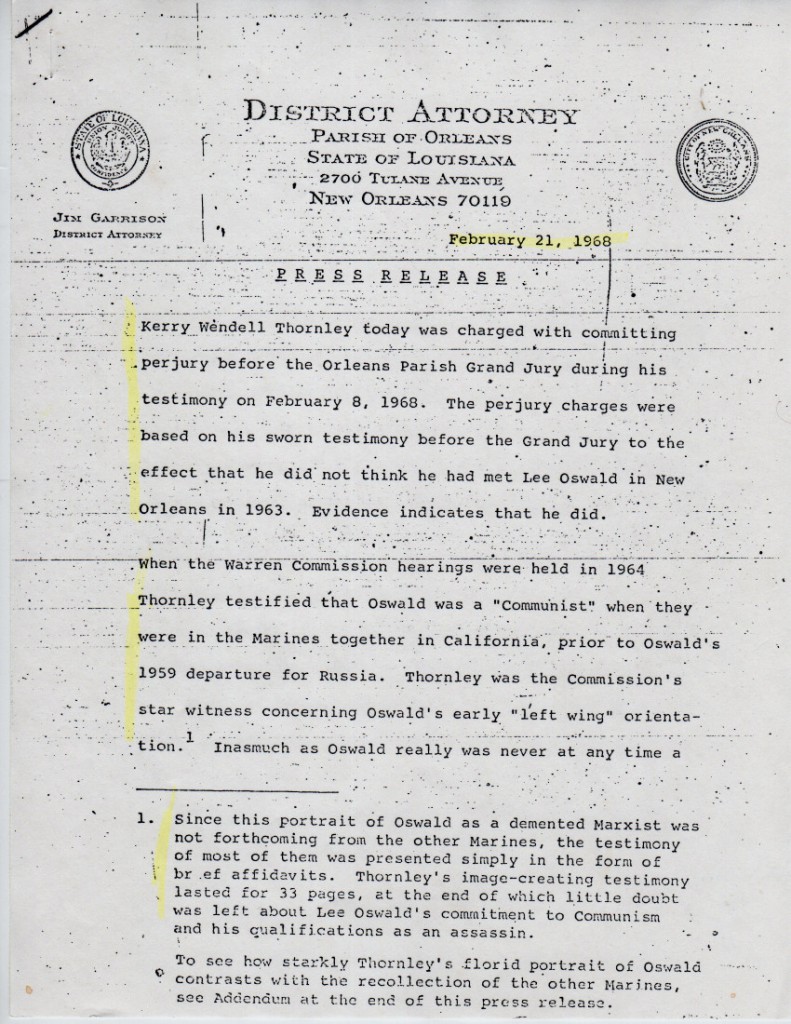
During the course of research for The Prankster and the Conspiracy: The Story of Kerry Thornley and How He Met Oswald and Inspired the Counterculture (Amazon), I was unable to pin down any tangible evidence supporting these Thornley-CIA allegations and eventually just wrote them off as more of Garrison’s unsupported theories. Thus it came as a bit of a surprise to me when—in 2006—I happened upon Joan Mellen’s Farewell To Justice (Amazon) which stated in its preface:
“Kerry Thornley, the Marine Corps buddy of Lee Harvey Oswald, who told the Warren Commission that Oswald was a Marxist, turned out himself to have been a CIA employee trained, according to a CIA document, in Washington D.C., in chemical and biological warfare…”
At the time, this claim that Thornley was a documented CIA spook came as quite the stunner, and shortly afterwards I shared Mellen’s provocative pronouncement with Thornley’s long time friend, Louise Lacey, whose initial response was a sudden burst of laughter, followed by: “Dear, if Kerry was CIA, I think I would have known.”
“Dear, if Kerry was CIA,
I think I would have known.”
—Louise Lacey
Louise, it should be noted, edited Thornley’s book Oswald for New Classics House back in 1965 and then later worked for Ramparts magazine as research director during Ramparts in-depth investigation of the JFK assassination, the first national magazine that was openly critical of the Warren Report. To this end, Louise worked alongside such notables as David Welsh, Mae Brussell, David Lifton and William Turner, and so when speaking of Thornley and/or the JFK assassination, Louise not only comes to the subject as someone who was a close friend of Thornley’s, but also someone involved very early on in JFK assassination research.
In Spring 2011, while conducting research for Caught in the Crossfire: Kerry Thornley, Lee Oswald and the Garrison Investigation (Amazon), I contacted Joan Mellen on how to go about obtaining a copy of this “CIA document” related to Kerry Thornley. Mellen replied that she’d send me a copy after she had time to recover from a recent medical ailment. Afterwards, I contacted Mellen periodically—on probably a half dozen occasions—but never heard back from her. Mellen, it should be noted, is still standing by her claim that Thornley was a CIA agent as evidenced in this recent interview.
More recently—on the advice of researcher Stu Wexler—I conducted a search of John Armstrong’s JFK assassination files at Baylor University online, where, lo and behold, I came across a copy of the document in question, which I post here for review.
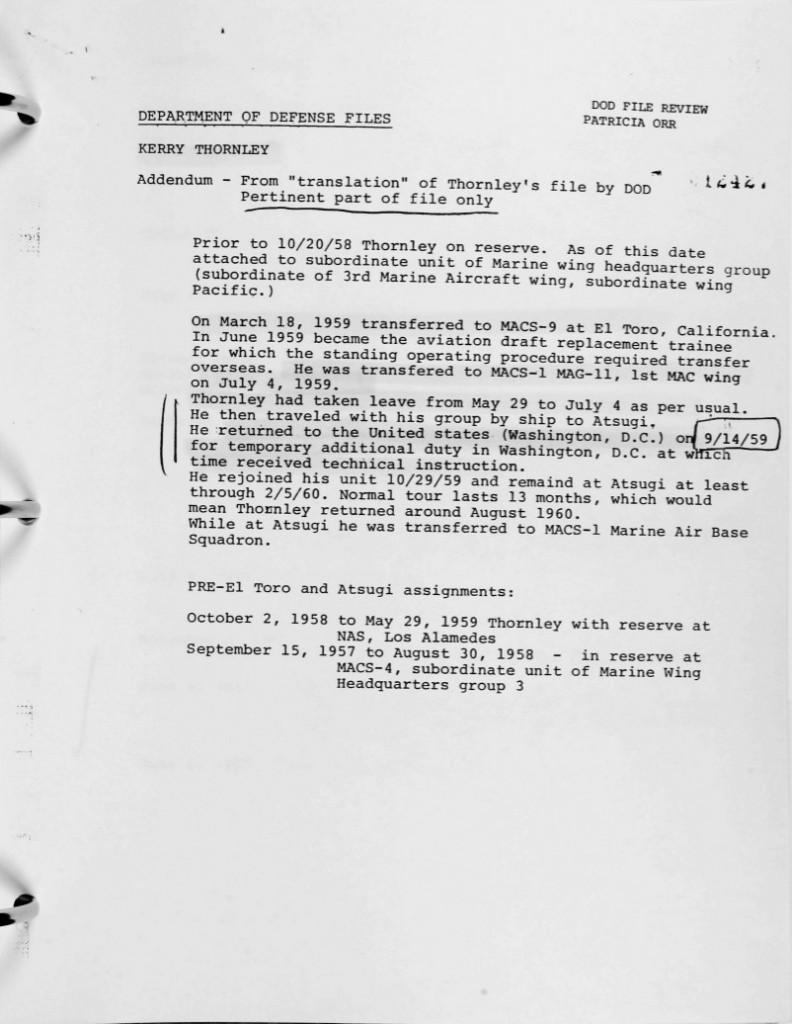
In Farewell to Justice, Mellen identified the above as a CIA document and, alternately, as a DOD document. Page one clearly identifies it as a DOD document “translation” which was created as a request to the DOD from the House Select Committee on Assassinations (HSCA) in 1978. The upper right hand corner of the document is stamped:
Patricia Orr was a researcher for the HSCA and it appears that the document is her translation of Thornley’s service record. The document confirms that Thornley received training in biological and chemical warfare, but how Mellen arrived at the conclusion that this training was conducted by the CIA is unclear. In fact, there’s no mention of the CIA anywhere in the document—unless one is reading deeply between the lines. Well, there are the three last letters of Orr’s first name to consider perhaps.
It should be noted that Thornley received this biological and chemical warfare training at Atsugi Base in Japan which served as a CIA outpost during this period. In this regard, it’s conceivable that Thornley—and other Marines stationed at Atsugi—could have received training from CIA personnel also stationed at the base, but Mellen’s assertion that Thornley was a CIA employee is unsupported by the DOD document. What the thinker thinks, the prover proves…
On page 276 of Farewell To Justice, Mellen writes:
“From the Department of Defense files comes a document placing Thornley as a CIA employee who attended Chemical and Biological Warfare School. Receiving ‘technical instruction’ in Washington, D.C., Thornley moved from ‘confidential’ to ‘secret’ clearance. His course in ‘Atomic, Biological and Chemical Warfare’ ran from June to August 1960, and had begun at Atsugi…”
The term Mellen uses—“technical instruction”—actually appears in Thornley’s service records as “Tech instruct” which was an abbreviation for “Technique of Instruction,” a Marine Corps competition Thornley entered during this period.
According to the author’s page of Oswald, Thornley “…served in the Far East, in the First Marine Aircraft Wing, and distinguished himself again as a public speaker on political/philosophical issues by winning first place in the Wing Technique of Instruction Competition. He was therefore sent to Washington to appear in the finals…”
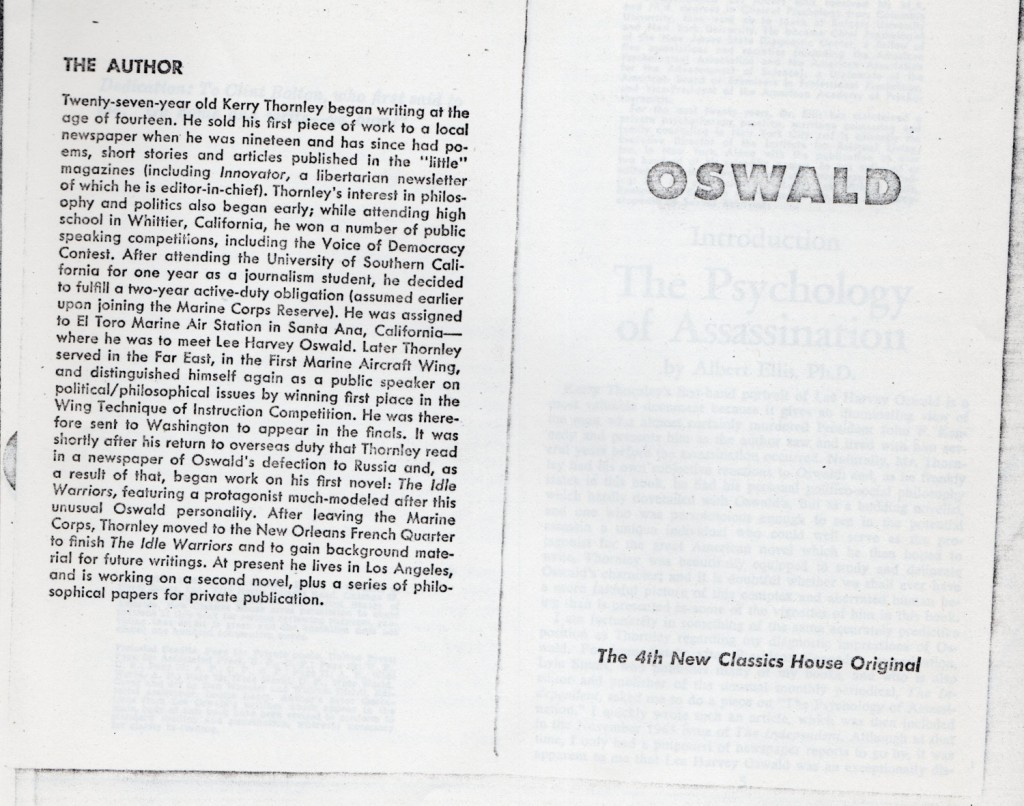
The August 1959 edition of Leatherneck magazine also mentions that the Technique of Instruction competition was scheduled to be held in September 1959 in Washington, DC., which is listed in an entry from page 3 of Thornley’s DOD file:
| 14 Sep 59 Tech instr |
to TAD | Wash, DC |
While Joan Mellen found Thornley’s visit to Washington, D.C. somehow suspect, his service record—and other supporting documents which I post here—suggest that he was simply attending a Marine Corps public speaking competition, which was certainly nothing unusual for Thornley. According to the author’s bio page in Oswald: “While attending high school in Whittier, California, [Thornley] had won a number of public speaking competitions, including the Voice of Democracy Contest.”
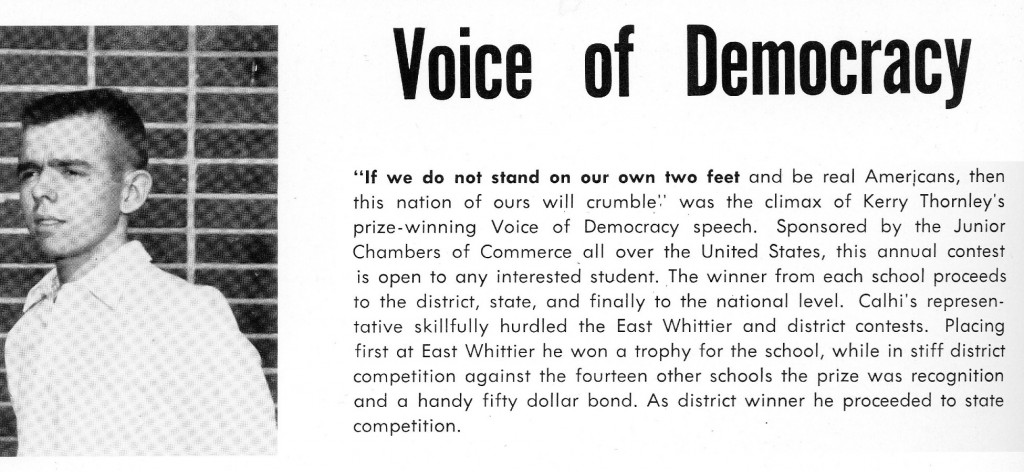
According to Joan Mellen, after Thornley received his “technical instruction” in Washington, D.C., in September of ‘59, he was “…moved from ‘confidential’ to ‘secret’ clearance….” This suggested (to Mellen, at least) that Thornley had graduated from Marines Corps Corporal to Secret Agent with the CIA.
It should be noted that “secret” clearance in and of itself is not special or unique and just because Thornley received “secret” clearance doesn’t mean he was a “CIA employee.” As my friend and former Air Force Office of Special Investigation (AFOSI) Special Agent, Walter Bosley, recently informed me:
“SECRET is the first level of anything close to serious, but it’s not the big prize level. It’s the first level of stuff that can get someone in big serious trouble if they mishandle it or, God forbid, sell it. There are a lot more personnel with SECRET than with TOP SECRET and beyond, of course, but it’s not insignificant.”
According to Thornley’s DOD file, he was assigned as “Avn Elec oper”, shorthand for Aviation Electronics Operator.
These duties were performed at Atsugi Base from which the U2 flights originated during this period, at the height of the Cold War. I would venture to guess that other enlisted men in Thornley’s unit who performed similar duties also held “secret” clearance.
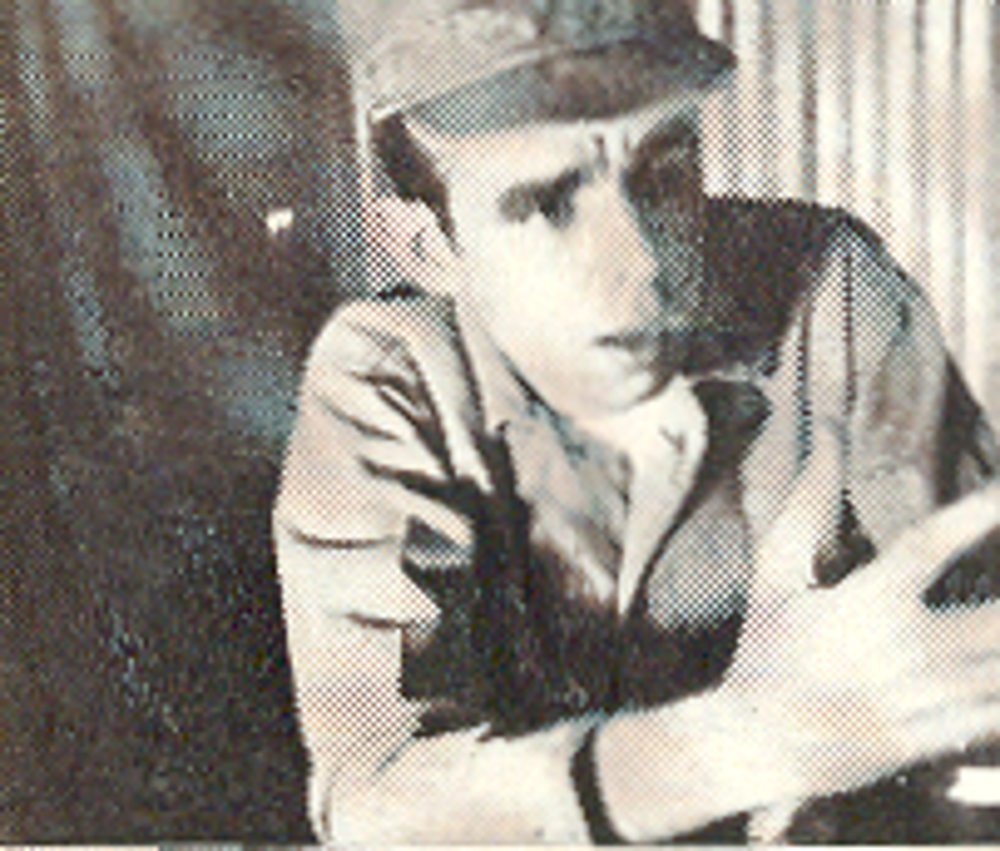
On page 67 of Farewell to Justice, Mellen endorses Garrison’s theory that the Old Post Office Building in New Orleans (also known as The Customs House) —located “across from Banister’s office”—was some sort of CIA spook central gathering place for, as Garrison described them, a “…number of young men who have been identified as CIA employees….” Garrison erroneously identified these CIA employees as Kerry Thornley, Lee Oswald, Thomas Beckham and Jack Martin, among others.
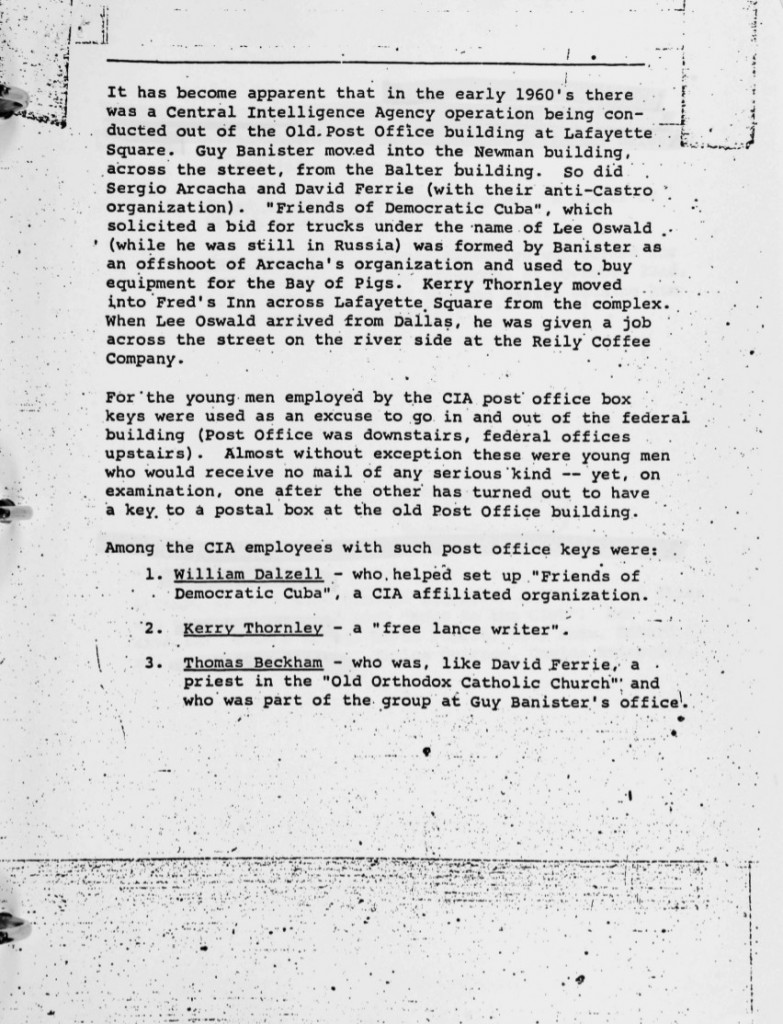
As it turns out, the Old Post Office Building was not exactly “across from Banister’s office” as Garrison described, but in reality a half mile away—or as Mellen more accurately notes in Farewell to Justice—in “close proximity.”
While Oswald was most likely involved in intelligence work during his Marine Corps service and afterwards, the claim that he was a CIA employee has never been conclusively demonstrated. To further suggest that Jack Martin or Thomas Beckham were CIA employees seems based primarily on the many sensational claims made by Beckham and Martin themselves in which I place little, if any, stock. This is not to say that I completely rule out any or all of these theories suggesting that Beckham or Martin might have been CIA agents or connected in some way to the Agency. However, these allegations are just that: theories to which Garrison never produced any substantial supporting evidence.
Lastly—to toss more water on this smoldering fire—I recently stumbled upon the following declassified CIA document (at the National Archives online database) dated January 1968.
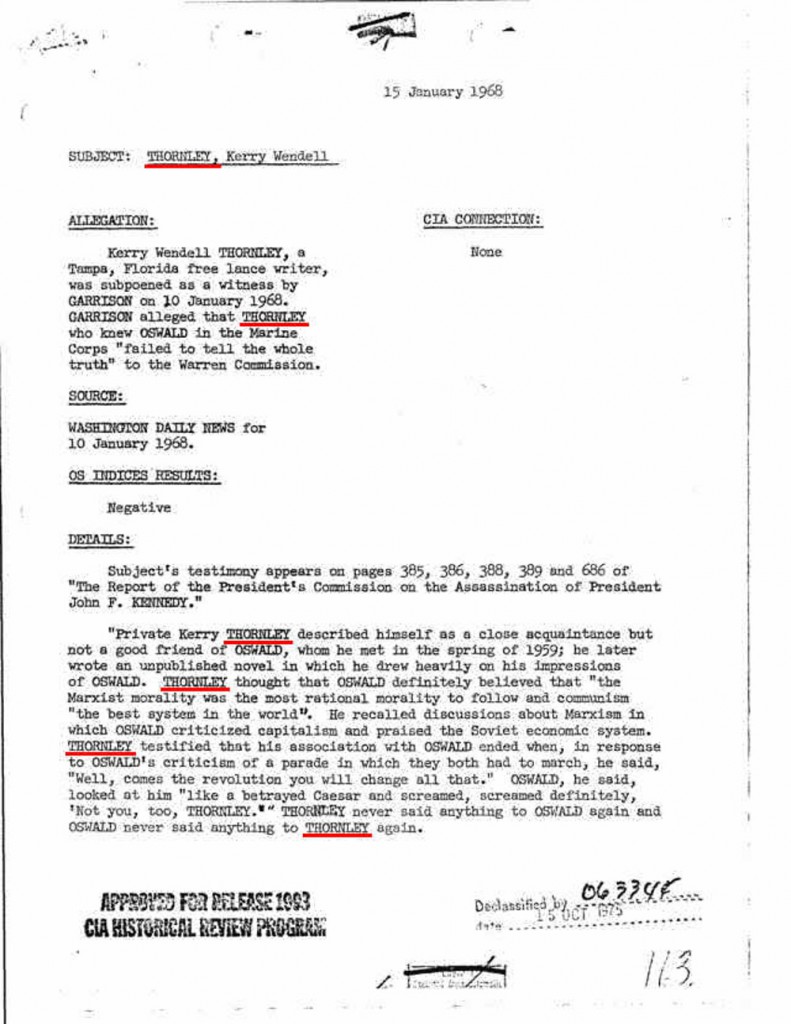
Given the 1968 date, one can assume that this document was prepared in response to Garrison’s allegation that Kerry Thornley was a CIA agent. In this regard, the document lists Thornley’s CIA connections as “None.”
But, of course, THEY would deny it!
“And so it is that we, as men, do not exist until we do; and then it is that we play with our world of existent things, and order and disorder them, and so it shall be that non-existence shall take us back from existence and that nameless spirituality shall return to Void, like a tired child home from a very wild circus.” —Principia Discordia, pg 00058
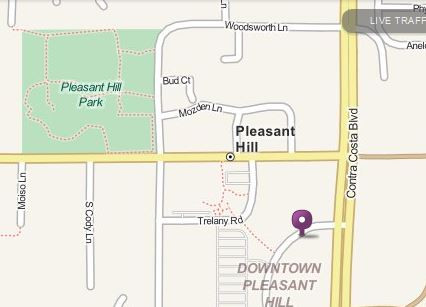
The address I used for the web search (of the last known whereabouts of Greg Hill) was actually the residence of a fellow named Allen “Bud” Simco, who was a long time friend of both Greg Hill and Kerry Thornley. In fact, Simco served in the same outfit as Lee Harvey Oswald and Thornley at El Toro Marine Base and actually wrote a chapter for Thornley’s book Oswald titled, aptly enough, “Oswald and Thornley.”
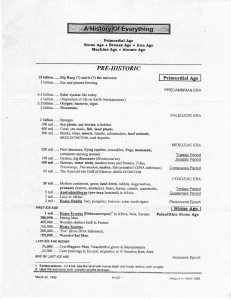
Simco lived right across the street from Greg Hill at the time of Hill’s passing, and during those final days—Simco told me—he was able to look directly across the street and see Greg through his home office window working at his computer on his final project, A History of Everything (Download PDF).
I was first informed of Greg Hills’s passing in an email from Bob Newport, which included a photo of Greg taken just a few days before he died with text below the photo announcing Newport’s successorship of the Norton Cabal Archives. In this regard, Newport was referring to the Discordian Archives later passed on to me, your humble Discordian chronicler, in 2009.
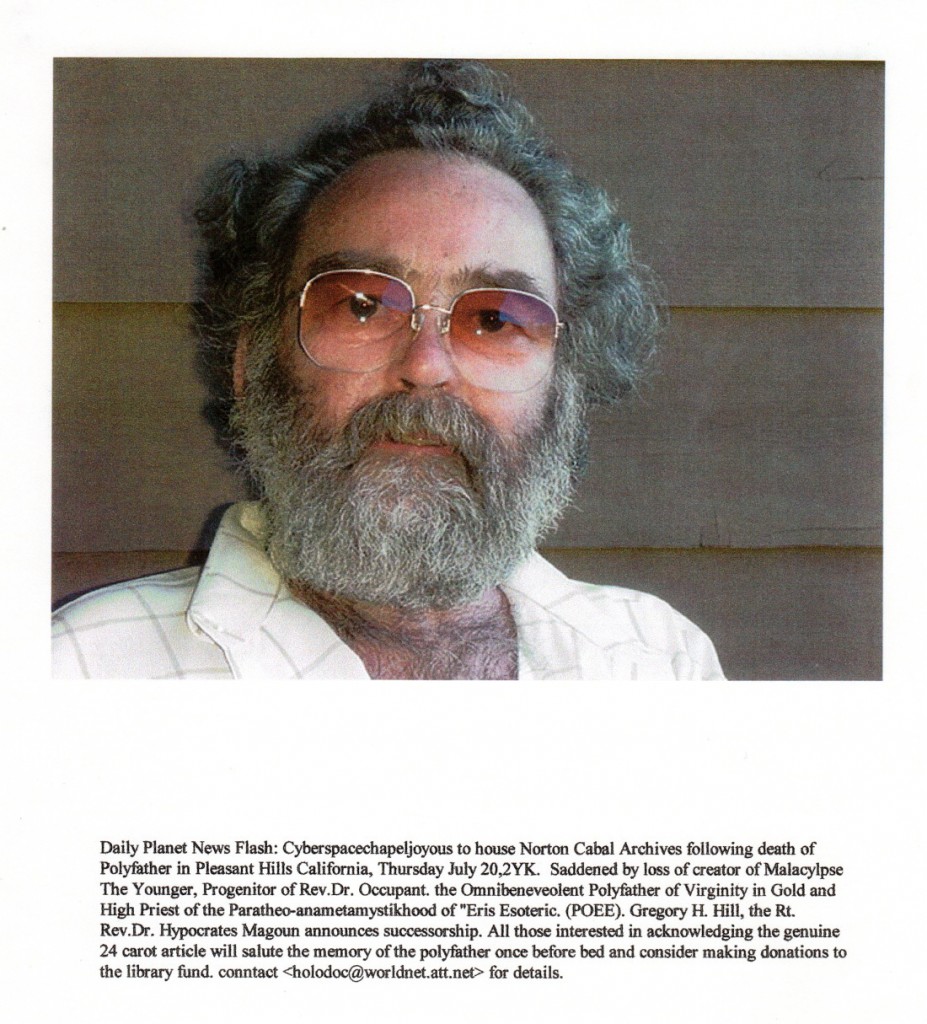
Below is an excerpted email from Allen Simco regarding Greg Hill’s passing, which gives a good snapshot of Greg in his final days.
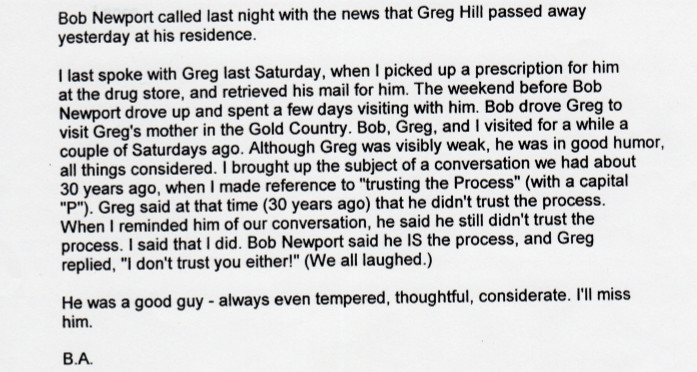
Greg Hill’s dear friends and fellow Discordians—Bob Newport and Louise Lacey—each wrote obits for Greg, shared with you here.
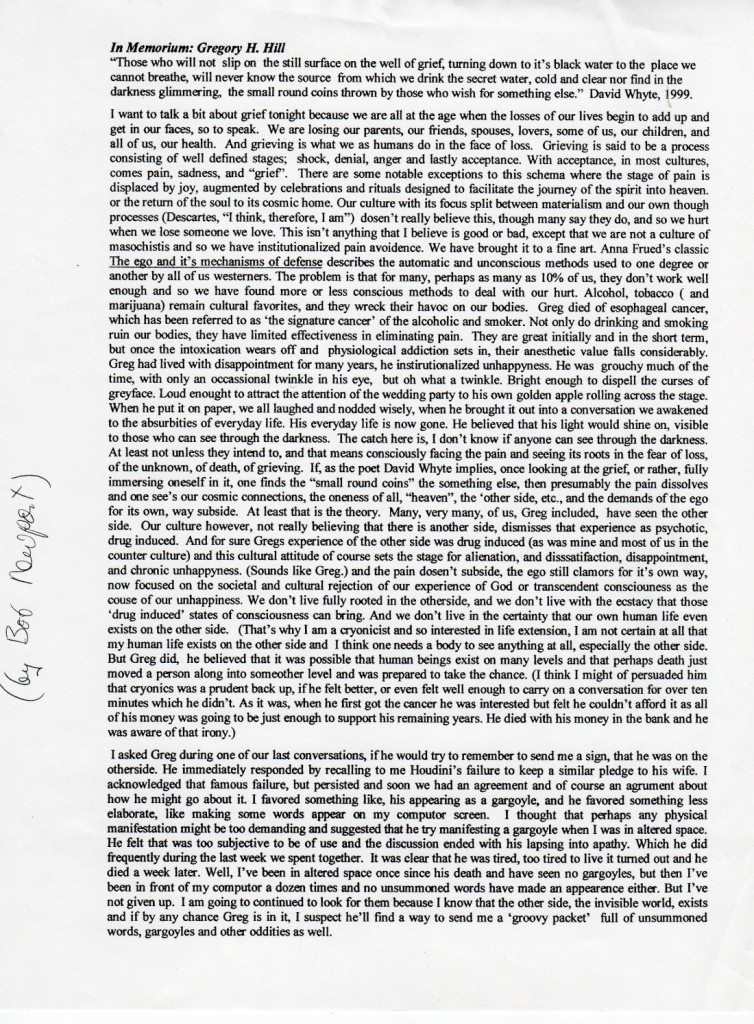
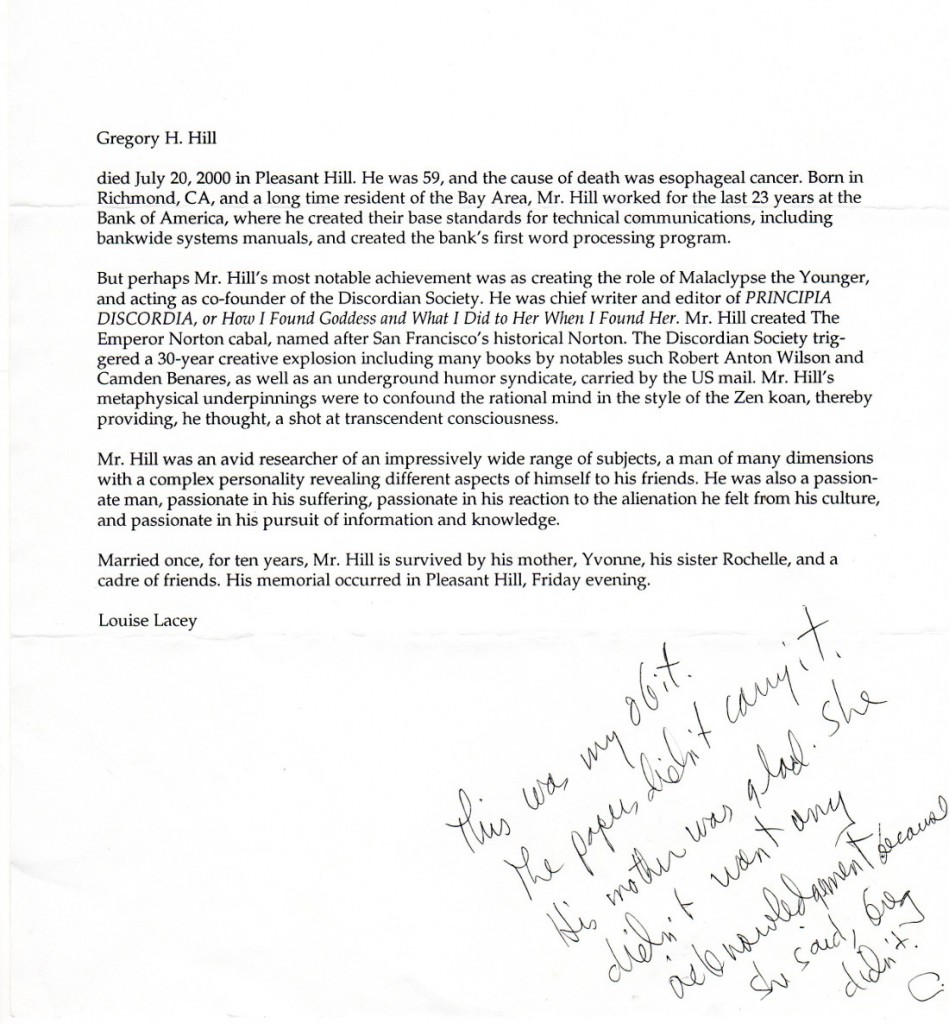

Sad news, my fellow Discordians. The Brunswick Shrine has gone dark!
The announcement came through the following news reports detailing the end of an era, the closure of the birthplace of Discordianism, the Friendly Hills Bowling Alley:
Whittier’s Friendly Hills Lanes closes
Three Historic L.A. Bowling Alleys Go Dark
And now, let’s take a look back at the Brunswick Shrine and its Erisian vibe with a series of Historia Discordia posts we like to call…
“Tales of the Brunswick Shrine”
Tales of the Brunswick Shrine (Part 00001)
Tales of the Brunswick Shrine (Part 00002)
Tales of the Brunswick Shrine (Part 00003)
Tales of the Brunswick Shrine (Part 00004)
Tales of the Brunswick Shrine (Part 00005)
